 Dear Colleague:
Dear Colleague:
It was a pleasure to see so many new faces and old friends at the Northeast TB Controllers Conference in Cleveland on October 12th & 13th. Those of you who attended this year’s TB-ETN/PEN conference in Atlanta probably noticed a new face in the room—Jennifer Campbell, our newest Training & Consultation Specialist. Jennifer has an MPH from the UMDNJ School of Public Health with a dual concentration in Health Education and Behavioral Sciences and Epidemiology, and previously worked at the School of Public Health for seven years doing outreach and education.
In this issue of the Northeastern Spotlight, our Behavioral & Social Science Series looks at a qualitative study about Mexicans and Tibetans currently being conducted by the New York City TB Program, highlighting the process used to identify and plan the study. Our staff profile features Carol Browning, Rhode Island’s energetic TB Nurse who is active both in the field and on the water. Contact investigation outcomes have been receiving a great deal of attention recently, and we take a look at contact investigation materials currently available from GTBI. We also go behind the scenes at our PA TB Update and learn about the Statue of Liberty’s TB connection.
Lee B. Reichman, MD, MPH
Executive Director
Northeastern RTMCC and the
Global Tuberculosis Institute
back to top
Spotlight Article on NYC DOH Foreign-Born Initiative
In past installments of this column, I have discussed research studies that had a behavioral/social science focus and/or used behavioral/social science methods. These methods do not require an extensive behavioral/social science background and can be used by any TB jurisdiction interested in achieving a better understanding of a particular patient group. As an example, this installment describes a study currently being conducted by the Bureau of TB Control, New York City Department of Health and Mental Hygiene (NYC DOHMH). As the study is on-going, this installment will not discuss results, but highlight the various issues involved in conducting such inquiries.
Background
Consistent with national trends, New York City has seen a rising proportion of foreign-born TB cases. Foreign-born patients became the majority of TB cases in 1997 and incidence in foreign-born populations has declined less quickly than in US-born populations (NYC DOHMH 2009). World TB Day events in 2010 highlighted the need to improve TB services and outreach for foreign-born populations. In January 2011, the Bureau of TB Control established the Stop TB in Foreign-Born Populations Initiative to determine the best ways to reach foreign-born populations.
After examining epidemiological data, the Bureau chose to focus health needs assessment efforts on two groups: Mexicans and Tibetans. In terms of country of origin, Mexicans comprise the 5th largest TB group in New York City. TB incidence among Mexicans is higher in NYC than in Mexico and high rates of molecular genotyping clustering have been found, indicating recent transmission. Tibetans have an extremely high incidence, a high proportion of molecular genotyping clustering, and a high rate of drug resistance. The ultimate goal of the Foreign-Born Initiative was to use research findings to develop specific interventions for these groups. The project has received support from all levels of the NYC DOHMH.
Design
The Bureau considered using a variety of data collection methodologies, including face-to-face interviews, focus groups, surveys, and small group interviews, before settling on two methods: 1) qualitative face-to-face interviews with patients, community leaders, community members, and health care providers, and 2) an anonymous web-based survey of DOHMH staff. Investigators chose to use qualitative interviews (i.e., mostly open-ended questions) in order to allow participants to identify a variety of responses and concerns. Plans to have focus groups with community leaders were stymied by concerns about participants’ complicated schedules.
The Bureau plans to conduct 50 face-to-face interviews. The interviewers are bilingual DOHMH staff members, interns and volunteers, many of whom were recruited to the project based on their language skills. Other jurisdictions may find it difficult to identify bilingual interviewers and may need to depend on outside interviewers or telephonic interpretation services. Mexican and Tibetan TB patients are selected from the TB Registry and are approached first by their case managers to assess their interest in participating in this voluntary study. Community leaders and members are identified through snowball sampling techniques. The questionnaires ask about healthcare-seeking practices, TB/LTBI knowledge and attitudes, experiences with TB screening and treatment, stigma, treatment adherence, social support, and experiences with DOH services. Community members and patients receive $30 gift cards as an incentive for participation.
All Bureau of TB Control staff were invited to participate in an anonymous web-based survey. Around 60% responded. The questionnaire explored issues in serving the foreign-born including interpretation, successful and unsuccessful efforts to reach these groups, and training needs.
Human Subjects Review
When TB jurisdictions collect information on patients, such efforts are often exempt from human subjects review because of its programmatic nature. With the Foreign-Born Initiative, the NYC DOHMH decided to apply for Institutional Review Board (IRB) approval for two reasons: 1) the face-to-face interviews included individuals who were not TB patients (e.g., community leaders and members); and 2) the Bureau planned to present research findings at conferences and other venues.
Training
The Foreign-Born Initiative involved Bureau staff with knowledge of TB and necessary linguistic skills. The investigators quickly determined that further training was needed on addressing cultural issues and qualitative interviewing skills. Also, staff who would be involved in data analysis required training on qualitative analysis techniques. These trainings were provided in collaboration with Bill Bower and Julie Franks from the Northeastern RTMCC.
TOPICS COVERED IN TRAINING |
Qualitative Interviewing |
- Differences between interviewing for qualitative research and other purposes, such as surveillance or contact investigation
|
- Characteristics of qualitative interview data: narrative, richness, tacit knowledge
|
|
- Phases of a qualitative interview: rapport building, parameter establishing, immersion, emergence
|
- Communication skills in qualitative interviewing
|
- Managing silence and distress
|
- Responding to requests for reciprocal disclosure
|
- Other challenges: transitions between questions and phases, probes and prompts, question order, phrasing and rephrasing
|
|
Cultural Competence |
- Basic principles of cultural competency
|
- How cultural and social factors affect a TB patient’s healthcare
|
- Key facts about Mexican and Tibetan history, culture, and migration to the US
|
- Demography and epidemiology of Mexicans and Tibetans in New York City
|
- Common terms for tuberculosis and traditional health beliefs of Mexicans and Tibetans
|
- Common ways of showing courtesy and avoid causing offense
|
- Elements of culturally sensitive interaction as an interviewer
|
Costs
The following costs are to be expected in conducting a qualitative health needs assessment:
staff time for planning, conducting interviews, data entry and cleaning, and analysis
- incentives for face-to-face interviewees
- transcription of taped face-to-face interviews
- qualitative software (see Resources below for free software from CDC)
- training for interviewers and for staff conducting qualitative analysis
Challenges
While the NYC DOHMH Foreign-Born Initiative is not yet complete, the investigators have identified several challenges. In reaching out to these two communities, they have tried to balance the specific concerns of each community with the need to have consistent methods across groups. A second challenge was negotiating the varying demands of time, budget, and project design. As indicated above, initial plans called for various data collection methods which had to be abandoned so that the project could move forward.
Conclusion
The NYC Foreign-Born Initiative study is presented as an example of what a jurisdiction could do to explore concerns among a specific group, be it an ethnic or other demographic group. The methods employed by the NYC DOHMH can be scaled to any level depending on available resources. A study could be conducted with an intern conducting a handful of interviews, or it could involve a large survey of randomly sampled individuals.
Resources
Martha Alexander (malexan1@health.nyc.gov) and Alexandra Camacho (asantanacamacho@health.nyc.gov) of the NYC DOHMH are willing to discuss their experience with those who might want to undertake similar efforts.
Sample interview guides from other projects can be obtained through the TBESC Translating Research into Practice (TRiP) page of the Find TB Resources website (http://www.findtbresources.org/trip.aspx).
Information about conducting a needs assessment may be found at:
http://www.nice.org.uk/media/150/35/Health_Needs_Assessment_A_Practical_Guide.pdf
The CDC offers a free qualitative data analysis software package, EZ-Text, available at eztext@cdc.gov.
References
New York City Department of Health and Mental Hygiene. Annual Summary 2008: New York City is Stopping TB. New York, NY. 2009.
back to top
Profile: Carol Browning, RN, MS, Consultant Public Health Nurse, Rhode Island Department of Health
 Carol Browning, the TB nurse for Rhode Island, began working with the Rhode Island Department of Health in 1987 and was one of the first HIV nurses in the state. She joined the TB program in 1993 and went to the TB Intensive at National Jewish Hospital, but six months later she was transferred to breast cancer for a couple of years. “Let me say, I really prefer infectious diseases!” Carol exclaimed. After spending nearly two decades primarily working with HIV, including teaching HIV testing and counseling and serving as an expert consultant for CDC in this area, Carol joined the Rhode Island Department of Health’s TB and STD programs in 2006.
Carol Browning, the TB nurse for Rhode Island, began working with the Rhode Island Department of Health in 1987 and was one of the first HIV nurses in the state. She joined the TB program in 1993 and went to the TB Intensive at National Jewish Hospital, but six months later she was transferred to breast cancer for a couple of years. “Let me say, I really prefer infectious diseases!” Carol exclaimed. After spending nearly two decades primarily working with HIV, including teaching HIV testing and counseling and serving as an expert consultant for CDC in this area, Carol joined the Rhode Island Department of Health’s TB and STD programs in 2006.
“Initially I thought I wouldn’t like TB,” Carol said. “It just didn’t seem exciting, unlike HIV in the 80s and 90s where I was on the hot seat all the time getting questions from the community. But TB is awesome and I really like it! I had no idea TB would have so many interesting and challenging cases.”
Carol particularly enjoys the investigation part of TB—going into a house, seeing whose picture is on the refrigerator and other clues to assist in locating contacts. “Once I was visiting a patient with a DOT worker, and the patient swore up and down there were no babies in the house. I saw something poking out from under a pillow on the couch, so I motioned for the DOT worker to pick it up, and underneath was a baby outfit!” Carol commented that compared to the other diseases she’s worked with, the face of TB is very different and comes with a lot more challenges both with languages and cultures as well as being involved with a whole family and not just the patient. “I used to be a hospice nurse, so from that experience I’m comfortable being in homes and working with families. And I have a lot of experience with interviewing skills and obtaining risk information from patients from working in the HIV program.”
Another aspect of TB Carol finds enjoyable is the chance to use her nursing skills and case management skills, along with the opportunity to work with so many different people including patients and professionals. “Rhode Island is both unique and fortunate in that more than 95% of TB patients are seen at the RISE TB Clinic at Miriam Hospital, which has a close working relationship with the Department of Health. Most of the time we’ll get a call from the TB clinic nurse letting us know that they have a suspect case coming in tonight, so they’re probably going to need DOT tomorrow. It’s not like we have to worry about patients being discharged from the hospital and we don’t know about it. It is seldom that we are not notified either by that hospital or the TB Clinic,” Carol says. “And because most of the providers are familiar with the TB Clinic, they just refer patients there. If I didn’t have this close working connection with the TB Clinic nurses and doctors, it would take a lot more effort reaching out to private providers, making sure there weren’t any changes in medications or treatments.”
Being part of a strong team with the Health Department and TB Clinic is one of the things Carol appreciates most about her position. “We have a weekly case management meeting attended by the health department staff, TB Clinic staff, and DOT workers where we review all the cases and tackle any challenges with the patients. There’s just one health department and one TB clinic, so we build up great relationships. I am fortunate to have a TB Program manager, Michael Gosciminski, who works with me on both TB and STD cases. When I first started in TB there weren’t really any charts. You’d open up a folder and it would just have a couple pieces of paper in it. Now we have real charts, and we developed them as a team” she added.
One of Carol’s more memorable TB cases was a 15-year-old boy who was born abroad but had lived in the United States for about a decade. He was symptomatic for a while and was finally diagnosed with active TB during Christmas break. “I spoke to parents, teachers, and students at the school,” Carol says. “I, along with Health Department physician, worked with the teachers to make sure they were giving the same message to students and parents as we were. And we held a meeting for parents, so they’d have time to have their questions answered.” The Health Department recruited some members of the Rhode Island Medical Team used during disasters to staff a clinic Carol led at the school. After that clinic turned up another active case, they had to go back and test the whole school.
“Overall, I feel like we do a good job testing contacts and doing DOT and generally working to keep TB under control in Rhode Island,” Carol says. “But I’m concerned that if money starts to leave the program, especially federal money, things could change. I hope that all diseases, including TB, get the money and staffing they need. We’ve seen many more people with B1 and B2 visas than in the past, and I like to think that’s a good development because we’re thinking more about TB and trying to do something about it. But then I was coming into work and heard on the radio that there were more than 80,000 cases of drug-resistant TB in Europe, and I thought to myself, ‘Am I dreaming that we can get this under control?’ But it’s certainly a much more exciting field than one would have thought!”
In her spare time, Carol competes in sculling and sweep rowing. Every morning she gets up at 4:20 am, rows from 5:30-7:00 am at the boat club, and then goes to work. “My non-rowing friends think I’m nuts!” Carol says. “But I get up in the morning and am surrounded by dozens of people doing the same thing, and it all seems so normal. Being in public health, it’s so great to be outside of public health with people who care about their health and eating well and exercising.”
She first got interested in rowing when she saw people rowing on the river as she drove her son to school and decided to start taking lessons. In almost 20 years of competitive rowing, Carol has won 65-70 medals, and she is Vice President of the rowing club, serves on the board, and does the organizing for the competitive women. Having won a gold medal at the Head of the Charles a few years back, as well as a bronze medal prior to that win, last year she came in 4th place and missed medaling by three second, and she’s headed back again this year in the four person sweep division to try and place again. According to Carol, when it comes to both rowing and tuberculosis, what really makes it work is the team!
Submitted by
Nickolette Gaglia, MPH
Training and Consultation Specialist
NJMS Global Tuberculosis Institute
Postscript: Carol and her teammates came in first place in their division at the Head of the Charles, 2011. Congratulations!

Carol Browning (second from left) with her teammates at the Head of the Charles Awards Ceremony, 2011.
back to top
Pennsylvania TB Update – 2011
GTBI’s most recent collaboration with the Pennsylvania TB Program was a 1-day course held in Hershey, PA on August 5, 2011. Months of planning culminated in a program for Pennsylvania clinicians, practitioners from health departments throughout the state, as well as providers working in “specialty” areas such as Infection Control, TB laboratories, etc.
Originally, the planning committee considered having afternoon breakout sessions, but ultimately decided that participants would want to attend all the sessions that we had planned. Including speakers and PA and GTBI staff, there were just over 100 people in the room!
Presentation topics were chosen based on what the TB Programs had been hearing from those in the field. Dr. Ed Zuroweste began with a talk about the epidemiology of tuberculosis – globally, nationally, and locally. This was followed by an overview of TB treatment by GTBI’s Dr. Lee Reichman. To address issues related to the laboratory diagnosis of TB, we recruited Lisa Dettinger from the PA Department of Health, Bureau of Laboratories. Dr. George McSherry, formerly GTBI faculty, now Chief of Pediatric Infectious Disease at Penn State Children’s Hospital focused on the management of TB in children and adolescents. And Dr. David Schlossberg, Philadelphia Dept. of Health discussed errors in the diagnosis and treatment of TB. Finally, Mark Wolman, Program Manager - TB Control at GTBI, addressed the importance of contact investigations in the control of tuberculosis.
We would like to acknowledge Tracina Cropper, Sr. Public Health Advisor – TB Department of Health – Division of TB/STD, TB Program Manager and Lisa Paulos for their hard work in planning this training, arranging the training venue, and recruiting participants. Beth Butler, Director of the TB/STD Division did a great job as MC and helped to keep us on time. In addition, we were pleased that Janice Kopelman, Deputy Secretary for Health Promotion and Disease Prevention, was able to join us for the entire day. Her presence and interest in TB validated the ongoing efforts of the TB health professionals in her state.
Submitted by
DJ McCabe, RN, MSN
Trainer and Consultant, Clinical Programs
NJMS Global Tuberculosis Institute
back to top
Contact Investigation Materials Available from GTBI
Contact investigation outcomes have received a great deal of attention recently. Since many TB programs are focusing on this indicator, we have highlighted some materials related to contact investigations which are currently available from GTBI. As always, if you have any questions about contact investigations, feel free to reach out to us—we are happy to offer advice and assistance!
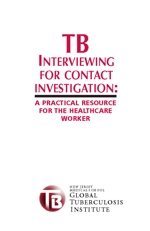
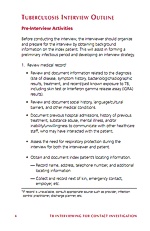 TB Interviewing for Contact Investigation: A Practical Resource for the Healthcare Worker
TB Interviewing for Contact Investigation: A Practical Resource for the Healthcare Worker
This resource set includes an interview checklist and detailed TB interview outline booklet. The checklist identifies the five components of a TB interview: pre-interview activities, introduction, information/education exchange, contact identification and conclusion, detailed in the outline.
http://globaltb.njms.rutgers.edu/educationalmaterials/productfolder/tbinterviewing.html
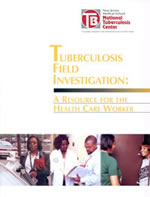 TB Field Investigation: A Resource for the Health Care Worker
TB Field Investigation: A Resource for the Health Care Worker
This resource describes the TB field investigation process including pre-investigation preparation, communication with individuals in the field, confidentiality, field safety and working with community providers. A checklist to be used during field work is also included. This product is available online only.
http://globaltb.njms.rutgers.edu/educationalmaterials/productfolder/tbfieldinvestigation.html
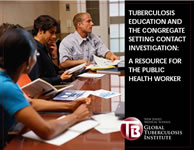 Tuberculosis Education and the Congregate Setting Contact Investigation: A Resource for the Public Health Worker
Tuberculosis Education and the Congregate Setting Contact Investigation: A Resource for the Public Health Worker
The TB education session is a vital part of the congregate setting contact investigation. This web-based resource will assist public health workers as they plan and conduct an effective TB education session in the congregate setting. Following the guidelines and using the PowerPoint ® presentation provided, they can teach the lay audience what it needs to know about TB transmission, infection, disease, skin testing and treatment. This resource includes: a complete, modifiable TB-education presentation, frequently asked questions about TB, specific to congregate setting contact investigations, TB vocabulary for lay audiences, pull-out TB fact sheet and an education session evaluation form. This product is available online only.
http://globaltb.njms.rutgers.edu/educationalmaterials/productfolder/congregatesetting.html
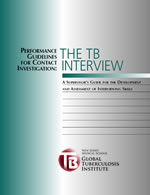 Performance Guidelines for Contact Investigation: The TB Interview
Performance Guidelines for Contact Investigation: The TB Interview
This manual provides a structured plan for the training, development and evaluation of healthcare workers involved in contact investigation. It focuses on interview techniques and communication skills and provides data collection instruments for the provision of objective feedback to the interviewer. This product is available online only.
http://globaltb.njms.rutgers.edu/educationalmaterials/productfolder/tbinterview.html
 Performance Guidelines: A Supervisor's Guide for the Development and Assessment of Field Investigation Skills
Performance Guidelines: A Supervisor's Guide for the Development and Assessment of Field Investigation Skills
This resource provides supervisors with methods for training and tools to assess a healthcare worker’s field investigation skills including ability to set priorities, locate patients and provide motivation and education to ensure medical evaluation, utilize appropriate investigation techniques and disposition investigations in a timely manner. This product is available online only.
http://globaltb.njms.rutgers.edu/educationalmaterials/productfolder/performingguidelines.html
 Tuberculosis Contact Investigation in Congregate Settings: A Resource for Evaluation
Tuberculosis Contact Investigation in Congregate Settings: A Resource for Evaluation
This resource is designed for use in the evaluation of contact investigations in congregate settings. The resource provides explanatory text and tools for assessing healthcare worker performance and skills as well as programmatic outcomes of contact investigations in congregate settings. This product is available online only.
http://globaltb.njms.rutgers.edu/downloads/products/Contact%20Investigations.pdf
For more products related to contact investigations, please visit the RTMCC Combined Products Page at: http://globaltb.njms.rutgers.edu/rtmccproducts.htm
Submitted by
Nickolette Gaglia, MPH
Training and Consultation Specialist
NJMS Global Tuberculosis Institute
back to top
Lighter Side: The Statue of Liberty's TB Connection
The Statue of Liberty turned 125 years old on October 28th, and one of the lesser-known facts about America’s most famous statue is that Frederic Auguste Bartholdi, the sculptor who designed it, died of tuberculosis.
Born in France in 1834, Bartholdi studied architecture and painting before becoming a sculptor. His career was beginning to flourish when the Franco-Prussian War began in 1870, and Bartholdi volunteered for military service. This experience sparked deep feelings of nationalism which can be seen in his work after this point.
The Statue of Liberty was a joint project between France and America, with France responsible for the statue and America for the pedestal upon which the statue would sit. It was originally scheduled for completion on the American Centennial in 1876, but lack of funds delayed the project and it was not completed until 1886, exactly a decade after the centennial. The famous inscription by American Jewish poet Emma Lazarus on the pedestal reads:
Give me your tired, your poor,
Your huddled masses yearning to breathe free,
The wretched refuse of your teeming shore,
Send these, the homeless, tempest-tossed, to me:
I lift my lamp beside the golden door.
Lazarus wrote these words in 1883 as part of a fundraiser for the statue, long after it had been designed, and the inscription was added to the pedestal seventeen years after the statue was erected.
The Statue of Liberty was originally intended to symbolize the friendship of America and France established during the American revolution, with the broken shackles symbolizing freedom from totalitarian governments as well as the freedom of American slaves. In World War I the statue’s image began to be depicted as a monument to American immigrants similar to is the predominant interpretation today.
Ellis Island became part of the Statue of Liberty National Monument in 1965, and today Lady Liberty continues to cast her shadow over the abandoned TB wards on Ellis Island.
back to top
Medical Consultation
GTBI faculty and staff respond to requests from providers seeking medical consultation through:
- Our toll-free TB Infoline: 1-800-4TB-DOCS and
- Email
During each consultation, the GTBI consultants will advise providers of TB Program resources for consultation in their jurisdiction. In addition, TB programs will be informed of TB cases with public health implications such as MDR/XDR-TB, pediatric TB in children <5, or potential outbreak situations.
More information about our consultation service, including downloadable Core TB Resources, can be accessed at Medical Consultant Web-Based Grand Rounds (http://globaltb.njms.rutgers.edu/services/medicalconsultation.html).
Periodically, designated TB program medical consultants are invited to participate in a web-based TB case conference (or grand rounds). Consultants are encouraged to present challenging TB cases on which they would like feedback from their colleagues throughout the Region. The next grand rounds will be held this Fall and we will notify TB programs when a date and time have been established. TB program medical consultants who would like to present a case should contact Dr. Alfred Lardizabal at 973-972-8452 or lardizaa@umdnj.edu.
back to top
Upcoming NE RTMCC Training Courses
Courses are open to participants in the 20 project areas (Maine, New Hampshire, Vermont, Massachusetts, Rhode Island, Connecticut, NJ, New York State, New York City, Pennsylvania, Michigan, Indiana, Ohio, West Virginia, Delaware, Maryland, Washington DC, Detroit, Baltimore, and Philadelphia) which are served by the Northeastern National Tuberculosis Center.
Individuals outside of this region who wish to attend our training courses should first contact their Regional Training and Medical Consultation Center to check if a similar course is being offered. If this is not the case, the out-of-region participant may then register for this course.
Click here for the list of upcoming courses.
back to top
Links - Other TB Resources
Division of Tuberculosis Elimination
The mission of the Division of Tuberculosis Elimination (DTBE) is to promote health and quality of life by preventing, controlling, and eventually eliminating tuberculosis from the United States, and by collaborating with other countries and international partners in controlling tuberculosis worldwide.
Find TB Resources Website
This website provides a central, comprehensive searchable database of international, national, state, and local TB-related education and training materials for TB healthcare workers, health professionals, patients, and the general public. Users can also submit their education and training materials as well find information on funding opportunities, TB organizations, TB mailing lists, and TB images.
TB Education & Training Network (TB ETN)
The TB Education and Training Network (TB ETN) was formed to bring TB professionals together to network, share resources, and build education and training skills.
Regional Training and Medical Consultation Centers' TB Training and Education Products
This website provides a searchable list of all 4 RTMCCs' resources.
TB-Related News and Journal Items Weekly Update
Provided by the CDC as a public service, subscribers receive:
- A weekly update of TB-related news items
- Citations and abstracts to new scientific TB journal articles
- TB conference announcements
- TB job announcements
- To subscribe to this service, click here
TB Behavioral and Social Science Listserv
Sponsored by the DTBE of the CDC and the CDC National Prevention Information Network (NPIN), this Listserv provides subscribers the opportunity to exchange information and engage in ongoing discussions about behavioral and social science issues as they relate to tuberculosis prevention and control.
Other RTMCCs
The Curry International Tuberculosis Center serves: Alaska, California, Colorado, Hawaii, Idaho, Montana, Nevada, Oregon, Utah, Washington, Wyoming, Federated State of Micronesia, Northern Mariana Islands, Republic of Marshall Islands, American Samoa, Guam, and the Republic of Palau.
The Heartland National Tuberculosis Center serves: Arizona, Illinois, Iowa, Kansas, Minnesota, Missouri, New Mexico, Nebraska, North Dakota, Oklahoma, South Dakota, Texas, and Wisconsin.
The Southeastern National Tuberculosis Center serves: Alabama, Arkansas, Florida, Georgia, Kentucky, Louisiana, Mississippi, North Carolina, South Carolina, Tennessee, Virginia, Puerto Rico, and the U.S. Virgin Islands.
back to top
Key Contacts
- Lee B. Reichman, MD, MPH - Executive Director
- Reynard J. McDonald, MD - Medical Director
- Bonita T. Mangura, MD - Director of Research
- Eileen C. Napolitano - Deputy Director
- Nisha Ahamed, MPH, CHES - Program Director, Education and Training
- Nickolette Patrick - Northeastern Spotlight Editor
- Alfred S. Paspe - User Support Specialist/Webmaster
back to top











